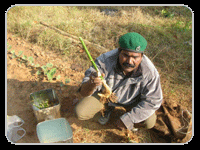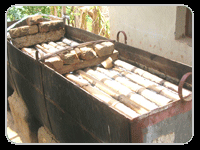
To increase the life of lingo-cellulosic materials, effective preservative treatment is essential. Like some of the timbers, bamboos when properly treated with suitable preservative become resistant to the attack of in sects and fungi. The service life is enhanced depending upon the proportion of penetration of the preservative. Various methods like diffusion, soaking, steeping and sap displacement etc. has been prescribed. Techniques for application of preservatives included brushing, spraying, dipping, hot and cold bath treatment, pressure treatment etc.
Post Harvest Protection of Bamboo from Insect Borers by a Technique Enhancing Starch Hydrolysis (KFRI, Peechi) The woody material of bamboo is highly susceptible to insect borers. The powder-post beetles (Dinoderus spp.) and their larvae, which feed on the culm tissues, are capable of causing enormous damage to the harvested culms and articles made from them. It has been found that, in a stack of bamboos subject to borer damage, culms that are heavily damaged are those with abundant starch; the culms that evade the attack are those with little or no starch.
The important conclusions that emerged from the study are:

Since harvesting during the low starch periods is not much practicable due to variability, it will be reasonable to schedule harvesting operation for the period when amylase activity and starch depletion are relatively higher (July-November).